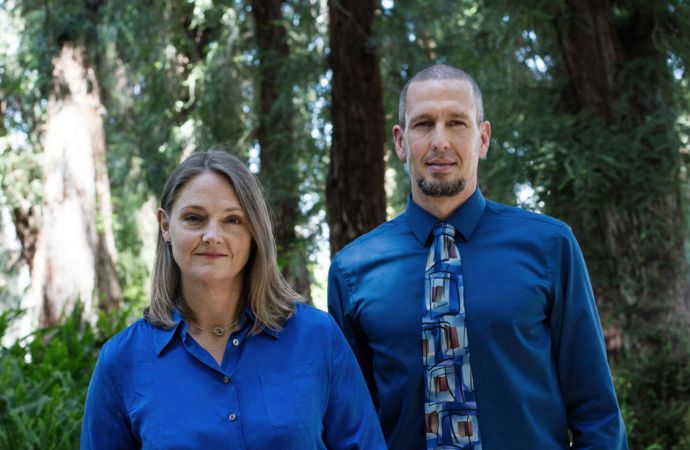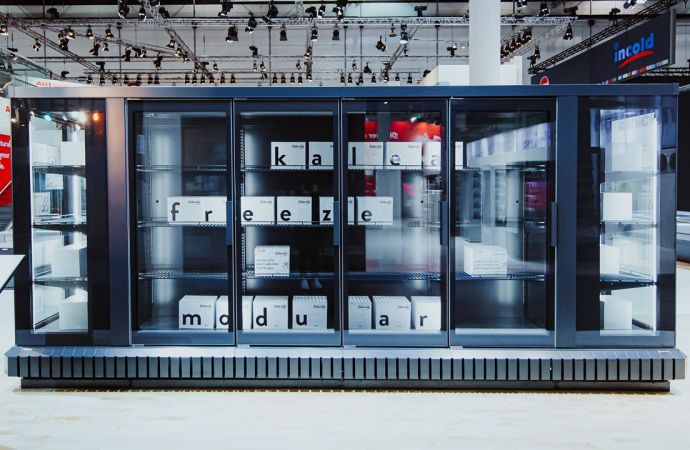The Sacramento Municipal Utility District breaks the mold by offering greenhouse-gas-reduction incentives – on top of energy-efficiency incentives – for natural refrigerant systems

Ryan Hammond & Kathleen Ave, Sacramento Municipal Utility District (SMUD).
One of the key impediments to the uptake of almost any new technology is its higher initial cost compared to the technology it is replacing. And that has certainly been true of natural refrigerant systems.
Apart from the rising sales of natural refrigerant equipment in North America, which are beginning to bring first costs down, there are a few factors that can change the cost equation for end users. One is regulation, such as the Environmental Protection Agency’s SNAP (Significant New Alternative Policy) program, which has started delisting HFC refrigerants with a high GWP (global warming potential), and the Department of Energy’s energy-efficiency requirements.
Another way to move past the cost hurdle is to receive financial help from a government or utility. In Japan, subsidies from the Ministry of the Environment have led to a massive deployment of transcritical CO2 systems between 2014 and 2016. While that sort of assistance is not available from the U.S. government, a growing number of U.S. utilities have begun providing funding for natural refrigerant systems that are more energy efficient than legacy equipment.
For example, in California, the most environmentally proactive state in the U.S., several utilities have started offering efficiency and demand-response incentives for natural refrigerant equipment, including Southern California Edison (SCE), Pacific Gas & Electric (PG&E) and the Sacramento Municipal Utility District (SMUD).
SMUD has now taken its incentive offering a significant step further.
On March 30, at a meeting at SMUD headquarters in Sacramento of the North American Sustainable Refrigeration Council (NASRC), SMUD announced a new pilot incentive program specifically aimed at natural refrigerant systems used mostly by supermarkets, convenience stores, cold-storage warehouses and food processors.
These systems include everything from transcritical CO2, low-charge-ammonia packaged equipment, ammonia/CO2, and self-contained propane or isobutane cases. SMUD worked with consulting firms WSP USA and KW Refrigerant Management Strategy in developing the natural refrigerants program.
What distinguishes SMUD’s newprogram from any other utility incentive scheme in the U.S. – and possibly the world – is that it rewards end users for not only energy efficiency but also for direct greenhouse gas (GHG) emissions reduction.
The GHG part could be a game changer.
SMUD originally planned to include HFOs and HFO blends in the program, requiring a GWP of less than 150 for new systems and a GWP less than 1,000 for retrofits of existing equipment. But after receiving feedback and upon “further reflection,” the utility decided to “go exclusively with natural refrigerants,” said Kathleen Ave, climate program manager for SMUD’s Energy Research & Development (ER&D) group. “We have limited incentive dollars and we want to achieve the best possible GHG reductions with those dollars.”
A ripple effect
On the one hand, SMUD’s natural refrigerant incentive program is limited, given its modest budget and the utility’s relatively small service territory (900 square miles). Yet the program, because of its GHG component, is “a big deal,” said Aaron Daly, energy manager for Whole Foods Market, and head of NASRC’s Utility Incentives and Energy Efficiency Progress Group.
U.S. utilities are typically reluctant to depart from the norm with incentives for natural refrigerant systems, Daly said. “Everyone is ‘racing to be second.’” But SMUD’s natural refrigerant program is sending a strong signal that will have “a ripple effect across North America,” he said. “To the extent that other utilities can point to the SMUD program and adopt one like it, that’s going to completely change the game for us.”
Daly distinguished between what’s realistic to expect from public utilities like SMUD and private, investor-owned utilities. “In the short term, what SMUD has done can be directly adopted by other public utilities,” he said. Private utilities are limited to offering incentives based on energy efficiency, and would need to convince regulators – the Public Utilities Commission in California – to allow them to implement a program like SMUD’s, with its GHG component.
However, Daly noted, energy efficiency projects are becoming increasingly expensive, opening up the possibility that private utilities will want to invest in both efficiency and GHG reduction.
Moreover, in California utilities are required to buy carbon offsets for the GHG emissions their plants produce, and Daly thinks they could make a case for buying offsets through their incentive programs with customers. “If regulators would allow them to do it, they could implement it very quickly and easily because they have all the program infrastructure in place.”
To the extent that other utilities can point to the SMUD program and adopt one like it, that’s going to completely change the game for us.”
– Aaron Daly, Whole Foods Market
Ryan Hammond, SMUD’s senior energy advisor, commercial services, sees GHG reduction becoming a bigger driver of utility value. “It’s still a long-term proposition, but this [program] is a good way to test the waters and begin structuring a whole program around it.”
At least one private utility, SCE, is working on incorporating “water and GHG incentive values” to go along with energy incentives, said Paul Delaney, senior engineer for SCE. “Including water and GHG reduction calculations would be really good in my opinion.”
Along with other major chains, Whole Foods has a small number of outlets in the SMUD territory. Though Whole Foods is not planning a major overhaul in those stores, Daly is interested in leveraging the SMUD incentives to replace self-contained display cases with propane cases, which the chain has installed throughout the U.S.
Red Bull, which has installed more than 200,000 Eco-Coolers containing isobutane in the U.S. (and about 780,000 globally), regards the SMUD program as “a great opportunity,” said Shira Norman, sustainability specialist for the Austrian beverage giant. “If we qualify for incentives through this program, we will certainly go after them. It’s very exciting from a sustainability standpoint to have as one of the utility incentives the use of low-GWP refrigerants.”
Norman also hopes that Red Bull will be able to “work with other utilities to create incentive programs similar to that of SMUD.”
SMUD’s incentive options
SMUD, a municipal utility governed by a seven-member board of directors serving four-year terms, has long offered a range of incentives for energy-efficient refrigeration equipment. These includes Custom and Savings By Design (SBD) incentives as well as prescriptive (deemed) after-installation rebates from the Express Energy Solutions program for low-cost (under $5,000) investments in refrigeration efficiency.
In rare cases, incentives for innovative cooling technology are available from the ER&D group, whose mission is to study technology that has not been widely implemented in the Sacramento area.
In 2014, Whole Foods received a “whole building” custom and ER&D efficiency incentive from SMUD for retrofitting an existing Sacramento store with a CO2 cascade system and other energy- saving components; the cascade system contributed about 20% of the energy savings.
SMUD’s natural refrigerant program works with its existing Custom Incentive and SBD programs to provide funding for energy efficiency; the former supports retrofits in an existing building, such as replacing a high-GWP-refrigerant system with a natural refrigerant system; and the latter provide funds for installing a natural refrigerant equipment in a new facility or one undergoing extensive renovation.
At least at the outset, the natural refrigerant program will not offer prescriptive rebates for equipment like display cases that use propane. “For now, [propane cases] will go through the custom program,” said SMUD’s Ryan. “But as more and more come online, we might make a determination that they go through the rebate program. And they would be eligible for the GHG emission component as well.”
For energy savings under the Custom Incentive Program, SMUD will offer an incentive of 10 cents per kWh of energy reduction, and $200 per kW of demand reduction. The total incentive is limited to 30% of the project’s cost or $150,000, whichever is less. (For the incentive structure under the SBD program, customers would contact SMUD.)
Separately, the program taps SMUD’s ER&D group to reward natural refrigerant installations for their direct GHG emissions reduction. SMUD will offer an incentive of $25 per metric ton of CO2-equivalent emissions reduction. This incentive is also limited to 30% of the project’s cost or $150,000, whichever is less.
All projects located in communities designated as disadvantaged (with preference to those in the top 10%) and implemented by small businesses will receive an incentive bonus equal to 25% of their GHG reduction incentive. To identify those communities, SMUD employs CalEnviroScreen, a mapping tool that helps identify California communities that are most affected by pollution, and where people are often especially vulnerable to pollution’s effects.
The combined energy and GHG incentives will be limited to 50% of the project’s cost or $250,000, whichever is less.
End users receiving incentives must agree to allow SMUD (or designated contractors) to collect energy consumption data from the natural refrigerant equipment with sub-metering devices over a three-year period to vet the accuracy of efficiency forecasts. They will also be asked to share annual refrigerant leak data for three years.
The GHG component of the program will enable SMUD to “test the waters in the region” for natural refrigerants, said SMUD’s Ave, adding, “It’s designed to help grow the market, mainstream the technology to the extent possible, and observe it.” However, she expects the GHG incentive offer to have a limited lifetime. “That’s typical for research programs; they’re generally shorter term. I’d like to have a good few years of participation.”
The program limits participation to one incentive per company, noted Hammond. “It’s a seed to get the idea out there.” After a retail chain uses the incentive to successfully implement a natural refrigerant system in one store, the expectation is that “they would apply it to other stores,” he said.
The incentive budget for the GHG reduction part of the program is between $500,000 and $600,000 for the first two years, said Ave, acknowledging its modest size. “We may exhaust the budget and just be in monitoring mode.” On the other hand, “we could augment [the budget] if we get a good response and positive initial results.” Ave would like to have a mix of natural refrigerant systems to study, including systems employed in disadvantaged neighborhoods.
The Custom Incentive and SBD budgets covering the energy efficiency side of the program “are a lot larger,” said Hammond, who declined to be specific. “They can dry up, but in five years I haven’t seen it yet.”
Setting the baseline
As with any incentive program, an essential element is the establishment of a baseline against which performance of the new system is measured. In the SMUD’s Natural Refrigerant Incentive Program, the energy efficiency baseline for custom incentives is the efficiency of an existing system when it was new; if the system is non-operational, then the baseline reverts to the California Energy Code or an industry standard, which are also used as the efficiency baseline for SBD incentives.
The GHG emissions baseline – as well as the GHG emissions for the natural refrigerant system – is the product of three factors: refrigerant GWP, refrigerant charge, and annual refrigerant leak rate. The difference in GHG emissions between the baseline system and the natural refrigerant system, multiplied by the default lifetime of the natural refrigerant system (15 years), produces the total estimated GHG emissions reduction used to award the incentive ($25/MtCO2-e).
For retrofits, the GHG emissions baseline uses the legacy refrigerant GWP and charge, while for new systems the GHG emissions baseline uses a default refrigerant GWP (2,107 for remote commercial systems and 2,676 for stand-alone systems) and a default charge (2.56 lbs. per MBTU/hr. of cooling capacity of the new system or 0.5 kg for a stand-alone system). A default annual refrigerant leak rate of 20% (or 8% for stand-alone systems) is used for both GHG emissions baselines, while engineering leak-rate estimates are used for the natural refrigerant system.
“SMUD will calculate the estimated emission reduction for customers, and information on the defaults and calculation methodology will be provided in program documentation,” said Hammond. SMUD will also consider a customer’s own estimate of GHG savings, as well as its estimate of energy and demand savings.
While securing utility incentives can often be a lengthy process but the SMUD program is offering relatively quick delivery. “To get an estimated incentive to a customer, we usually allow about a two-to-three-week turnaround,” said Hammond. “The final incentive is issued within about two weeks from when the project is installed and operational."
At press time, SMUD had not yet started receiving applications for incentives under the program. But there is a lot of interest, including several “strategic accounts” (supermarkets and refrigerated warehouses) from which SMUD has received “positive response” to outreach efforts, said Ave.
Even with the availability of financial incentives, the biggest challenge facing the natural refrigerants incentive program, said Ave, will be persuading end users to break out of their comfort zone when it comes to refrigeration technology. “It’s getting people to consider these alternatives that may not be as well known, and to trust that there’s an ecosystem – particularly design and maintenance – to support them. You can’t accomplish that overnight and just with incentives.”
Ave is hopeful that local community colleges and other organizations with HVAC&R technical programs will get involved “to help broaden awareness and make the market transformation happen.”
Daly of Whole Foods agreed that a key barrier to natural refrigerant adoption remains the attitude of an organization toward developing new technologies. “Many organizations say ‘if it ain’t broke don’t fix it,’” he said. “So unless we have a clear signal in the marketplace suggesting a reason to do otherwise, there’s just the inertia of what’s always been done.
“That’s why I think what SMUD’s done is such as big deal.”
To read the complete cover story on SMUD’s natural refrigerant incentive program, click here.
Related stories



